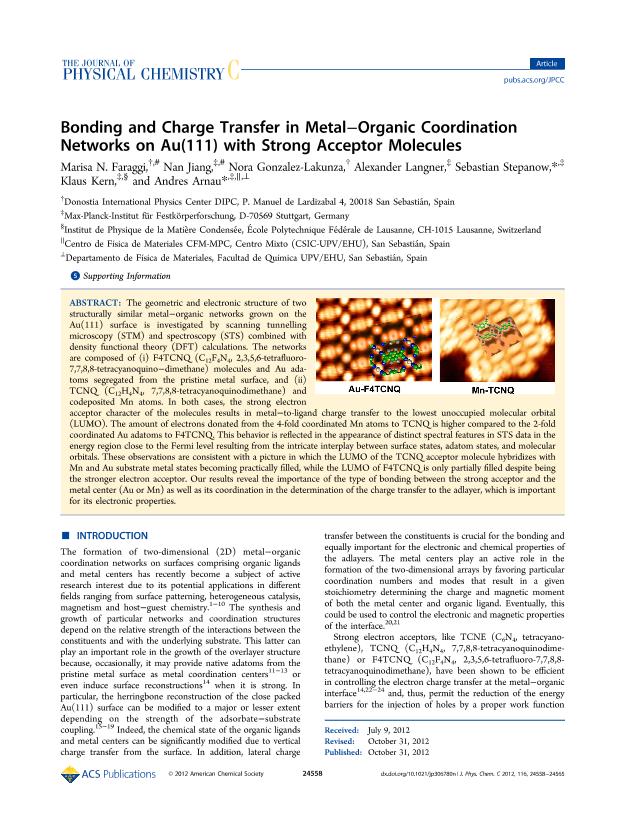Artículo
Bonding and Charge Transfer in Metal–Organic Coordination Networks on Au(111) with Strong Acceptor Molecules
Faraggi, Marisa Noemi ; Jiang, Nan; Gonzalez Lakuntza, Nora; Langner, Alexander; Stepanow, Sebastian; Kern, Klaus; Arnau, Andres
; Jiang, Nan; Gonzalez Lakuntza, Nora; Langner, Alexander; Stepanow, Sebastian; Kern, Klaus; Arnau, Andres
 ; Jiang, Nan; Gonzalez Lakuntza, Nora; Langner, Alexander; Stepanow, Sebastian; Kern, Klaus; Arnau, Andres
; Jiang, Nan; Gonzalez Lakuntza, Nora; Langner, Alexander; Stepanow, Sebastian; Kern, Klaus; Arnau, Andres
Fecha de publicación:
10/2012
Editorial:
American Chemical Society
Revista:
Journal of Physical Chemistry C
ISSN:
1932-7447
Idioma:
Inglés
Tipo de recurso:
Artículo publicado
Clasificación temática:
Resumen
The geometric and electronic structure of two structurally similar metal–organic networks grown on the Au(111) surface is investigated by scanning tunnelling microscopy (STM) and spectroscopy (STS) combined with density functional theory (DFT) calculations. The networks are composed of (i) F4TCNQ (C12F4N4, 2,3,5,6-tetrafluoro-7,7,8,8-tetracyanoquino–dimethane) molecules and Au adatoms segregated from the pristine metal surface, and (ii) TCNQ (C12H4N4, 7,7,8,8-tetracyanoquinodimethane) and codeposited Mn atoms. In both cases, the strong electron acceptor character of the molecules results in metal–to-ligand charge transfer to the lowest unoccupied molecular orbital (LUMO). The amount of electrons donated from the 4-fold coordinated Mn atoms to TCNQ is higher compared to the 2-fold coordinated Au adatoms to F4TCNQ. This behavior is reflected in the appearance of distinct spectral features in STS data in the energy region close to the Fermi level resulting from the intricate interplay between surface states, adatom states, and molecular orbitals. These observations are consistent with a picture in which the LUMO of the TCNQ acceptor molecule hybridizes with Mn and Au substrate metal states becoming practically filled, while the LUMO of F4TCNQ is only partially filled despite being the stronger electron acceptor. Our results reveal the importance of the type of bonding between the strong acceptor and the metal center (Au or Mn) as well as its coordination in the determination of the charge transfer to the adlayer, which is important for its electronic properties.
Palabras clave:
Surface
,
Network
,
Molecule
,
Acceptor
Archivos asociados
Licencia
Identificadores
Colecciones
Articulos(IAFE)
Articulos de INST.DE ASTRONOMIA Y FISICA DEL ESPACIO(I)
Articulos de INST.DE ASTRONOMIA Y FISICA DEL ESPACIO(I)
Citación
Faraggi, Marisa Noemi; Jiang, Nan; Gonzalez Lakuntza, Nora; Langner, Alexander; Stepanow, Sebastian; et al.; Bonding and Charge Transfer in Metal–Organic Coordination Networks on Au(111) with Strong Acceptor Molecules; American Chemical Society; Journal of Physical Chemistry C; 116; 10-2012; 24558-24565
Compartir
Altmétricas



